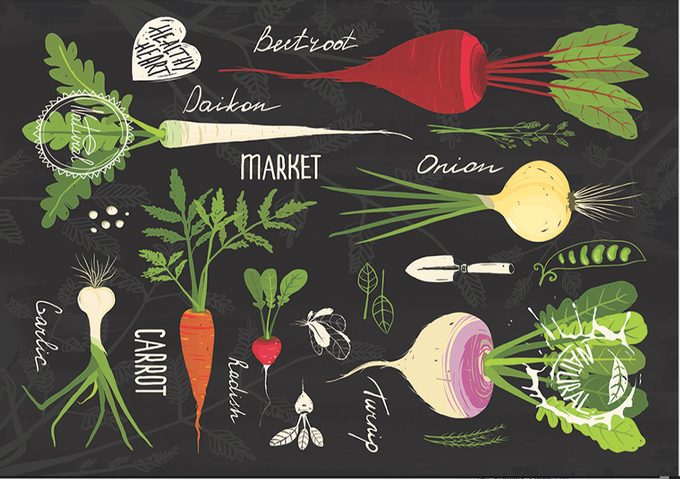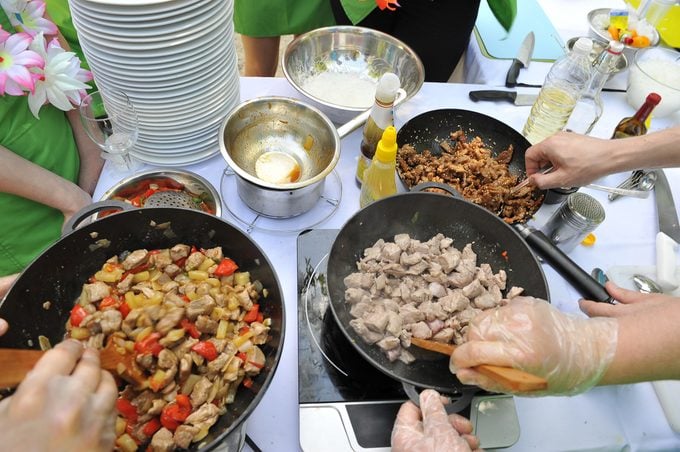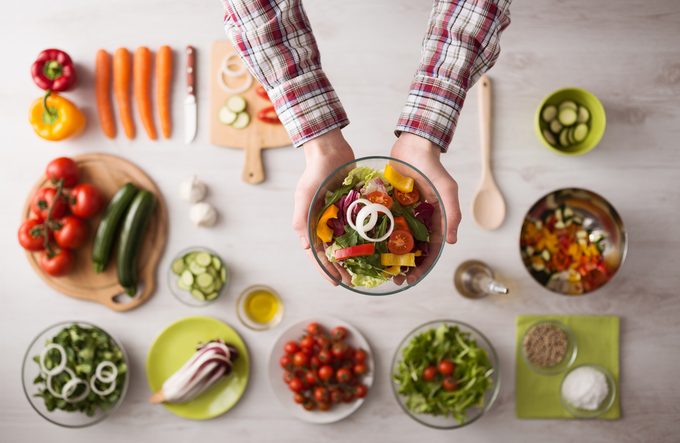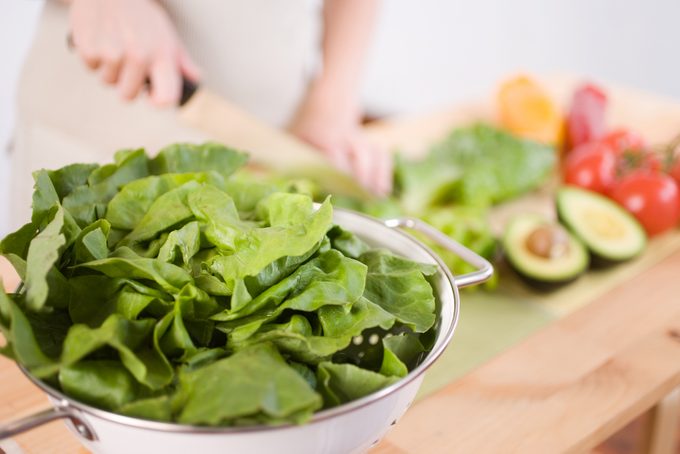Hungry For Change: The Food Centre Revolution
Community food centres provide nourishment – in more ways than one. It’s all thanks to the vision of one cool Canuck who’s looking to improve access to healthy food in low-income communities.

Hungry For Change
It’s almost noon. Nick Saul strides into the Regent Park Community Food Centre in Toronto. Local residents are taking their seats for lunch. There’s no cafeteria-style lineup in the light-flooded space; volunteers will serve the food – all made from scratch. Some of the veggies were grown in a garden just outside – a green oasis in this transitioning neighbourhood, built in the 1940s as a public housing estate. “When someone comes to a meal at the Regent Park Community Food Centre, they are served at the table,” says Saul. “They don’t have to stand in a lineup. It’s one of the ways we try to create more dignified and respectful spaces.”
Each month, more than 850,000 people use a food bank in Canada – a 26 percent rise since 2008. Tall and lean with silver hair, a gentle smile and a determined, blue-eyed glint, 50-year-old Saul is on a mission to improve access to healthy food in low-income communities and help people build better health, improve their food skills and create more connected and engaged communities. He doesn’t see food banks as a long-term solution.
The Holistic Vision
The president and CEO of Community Food Centres Canada first moved away from the charitable model in 2001, when he and his colleagues began transforming The Stop, located in Toronto’s Davenport neighbourhood, from an emergency food bank into a new kind of holistic community food centre. His vision was for a more dignified, respectful and welcoming space, with a multi-pronged approach to food insecurity. “People don’t want to be recipients of charity; they want to be cooks and gardeners and engaged citizens, improving not only their own health but also their neighbourhoods,” says Saul.
Thanks to private donations, grants and fundraisers, The Stop began offering cooking workshops – some led by staff, some by residents of the multicultural neighbourhood. They introduced healthy community meals, community gardens, an affordable farmers’ market and grassroots advocacy around food and poverty issues. When British chef and good-food champion Jamie Oliver visited in 2010, he said, “I’ve travelled all around the world and I’ve never seen anything like The Stop – every city should have one.”

A Food Centre Revolution
Saul felt the same. In 2012, he began rolling out Community Food Centres (CFCs) across the country. Six have launched to date, across Ontario, Manitoba and Nova Scotia. Two more will open this year in Calgary in late summer and in Hamilton, ON, in late fall.
Each new CFC is modelled on the Community Food Centre model developed at The Stop and created in collaboration with a local partner already rooted in the community and adapted to meet the unique needs of its users. Take Regent Park, Toronto’s second CFC, for example. The neighbourhood is often a first stop for newcomers to Canada, and it’s located beside the Gay Village in an area with several homeless shelters. Here, staff and volunteers offer programs that include a free community lunch, a global seed bank, gardens, cooking workshops and an advocacy office that helps people access supports, and it held a voter registration outreach during the past election.
Up to two years of work go into identifying local needs and customizing a building and programming before a CFC opens. Saul compares each ribbon-cutting ceremony to a birth.
“I was recently there for the opening at the Dartmouth,” he says. “The place was packed, and the atmosphere was electric. People were so proud of this beautiful centre in a community that desperately needed beauty and a place to come together. The chef stood up and spoke about the healthy dishes he had created with volunteers, and a peer advocate talked with such passion about the importance of marrying good food programming with speaking out. After the event, I had a plane to catch, but I could have just floated home.”
“If I tell the chef I don’t like something, I mean I just don’t like it yet,” says Vel Oakes, a regular at the Dartmouth North Community Food Centre. She tried kale three ways before developing a taste for it – in a salad with vinaigrette. Her next challenge: quinoa.
A Place To Give Back
Downsized two years ago, 51-year-old Oakes is living off the last of her savings and looking for work. She has two university degrees and 20 years of administrative experience. Oakes was first enticed to her local CFC by the aroma of good coffee. By the time she had drained her mug, she was filling out a volunteer application form.
“In a soup kitchen, people line up, shuffle in and shuffle out,” she says, “but at the centre, you are served. You have real cutlery, and you have stoneware to eat off. Yes, the water glasses are plastic, but that’s a good thing because kids like to throw them.”
Oakes helps in the kitchen, dining room, garden and peer advocacy office. She didn’t actually think she could cook, but that changed when she and a 15-year-old fellow volunteer made their first quiche together at a CFC workshop six months ago. Now she chops, stirs and seasons raw ingredients daily, both here and at home.

Fresh Food For All
“Anybody’s circumstances can change, and anybody can find themselves in need of a good meal,” says Oakes. “Here, nobody asks questions, and everybody is treated with dignity.”
“You can easily buy a slice of pizza or fried chicken around here but not affordable fresh vegetables,” says Kristina McMillan, director of the NorWest Co-op Community Food Centre. “Some people even have to buy food at dollar stores.”
A project of NorWest Co-op Community Health Centre, that is located in a newly renovated facility in Winnipeg’s Inkster neighbourhood, NorWest has welcomed more than 500 hungry people each week since opening in February 2015. McMillan has observed friendships and support systems blossom between community members who coexisted before: first- and second-generation Filipinos, East African refugees, First Nations and Métis residents, families living in social housing, and seniors who live alone.
Visitors and staff share lunches in a dining room with 15-foot ceilings, where the menu is written on a funky vintage chalkboard. Floor-to-ceiling glass windows look out on raised-bed gardens, and the laughter and chatter of volunteers carry into the dining room from the open-concept kitchen. “In summer, people can see food growing and being cooked, eaten and shared all in the same space,” says McMillan. “It’s great to make those connections.”

From The Garden To The Table
McMillan oversees 16 cooking, gardening and self-advocacy programs in the 4,000-square-foot space and encourages anyone who comes for the food to check out the healthcare resources, too. There’s everything here, from diabetes testing to breastfeeding support.
Her favourite program? A healthy smoothie club for kids. “Youth drop in after school and put the ingredients they like in a blender jug,” she says. “Then they pop it onto the back of an adapted exercise bike and pedal to power the blender blades. It’s a big hit!”
Every Wednesday from Mid- July until the end of August this year, Sean Brathwaite checks in with volunteers at Taste of Regent Park, a pilot project of the Regent Park CFC. Local residents have been trained to prepare, bake and sell goods, as well as run the oven at some of these community events.
A rooftop gardener and owner of one of the first condos built as part of a mixed-income revitalization project, Brathwaite loves getting to know fellow residents as a market volunteer. “It’s a culturally diverse community and there is a little bartering – it’s fun to interact with the customers,” he says.
Creating Healthy Communities
The Taste of Regent Park pilot project launched in 2015 and included Good Food Market – a FoodShare program that provides affordable fresh produce. Gardeners from the Yonge Street Mission’s garden program sell their surplus of coveted veggies, like beets, radishes and lal shak (a Bengali red spinach), at some of the markets. The food coordinator and volunteers also prepare market-fresh ingredients for free sampling to give customers ideas on how to use what they buy.
Nearby, community groups set up booths to inform residents about everything from employment opportunities to legal aid services. DJs, dancers and jugglers come to entertain the crowd. Brathwaite loves seeing the teen media crew participate. “They do live interviews with vendors and broadcast them on their radio show,” he says.
New this year is a Repair Café where people can get things fixed for free, but the biggest draw on market day is the community cookout and movie in the park. People lay out picnic blankets and eat together for a token donation, then catch a blockbuster.
“A lot of people who come to the market say they’ve met someone new,” says Brathwaite. “And knowing your neighbours creates good feelings of inclusion and safety.”
3 Ways You Can Help:
1) Volunteer
Help out at your nearest CFC a few hours a week. Find the closest location at cfccanada.ca
2) Donate
Make cash donations or even transfer Aeroplan Miles. Donate at cfccanada.ca/donate or beyondmiles.aeroplan.com
3) Participate
Dine at one of more than 50 Canadian eateries participating in the annual Restaurants for Change fundraiser. Find out more at restaurantsforchange.ca
Recommended:




